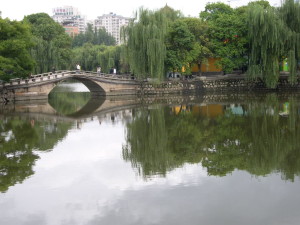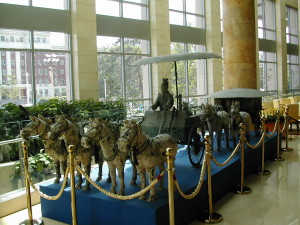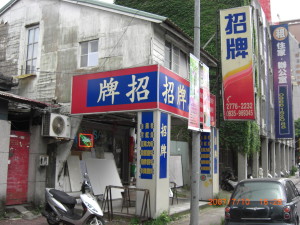Books, Newspapers and Printed Dictionaries
Chinese can be written in books and newspapers in a number of different ways.
Historically, Chinese was written vertically in columns from the top to the bottom of the page, starting on the right and moving to the left, column by column …and books would start from what in English would be considered the back, moving to what would be the front English-style.
While perhaps not a cause of this style of writing, it was certainly reinforced by the fact that vertical bamboo strips were used as a writing surface before the invention of paper (which is usually assigned the date 105ce as the date of invention, in China).
These bamboo pieces would then be stitched together side-by-side to form scrolls, which were perhaps one of the earliest form of ‘books’ in the ancient world (…with the possible exception of scrolls written on tanned lambskin in ancient Israel.)
This vertical style is the traditional method for writing Chinese …and some newspapers and books are still printed that way in both Táiwān and China.
However, Chinese may also be printed horizontally from left to right across the page (just the same as English). Or, it may be printed horizontally from right to left, across the page …the opposite to the English style, but the same as Arabic and Hebrew.
Books and newspapers may be found printed in any of these three styles in China and Táiwān, today.
Reading Chinese Characters
The most efficient use of the written form of a language is when the writing is ‘transparent’ to the reader. Obviously, the less difficulty that the reader has in interpreting the written form, the better able the reader is to use the written language.
This may seem academic, but the experience of readers of phonetic languages is illustrative of the fact that phonetic languages are actually very unsuccessful in achieving this kind of efficient use: for all phonetic languages, the reader must first (silently) pronounce the word, before recognition of the meaning is clear.
A parallel example to illustrate ‘transparency’: when a typist is using a keyboard and wants to type a letter such as ‘a’, for example, a touch-typist will simply ‘think’ the letter ‘a’ and type it on the keyboard (…note that the typist doesn’t think about the location of the letter on the keyboard, or what finger to use to strike the key.)
When Chinese native-speakers read the written Chinese language, they don’t have to read (and pronounce) the spoken form of the character in order to understand the meaning of the characters.
They look at the character and immediately ‘see’ the meaning without the intermediate step of silently ‘saying’ the sound of the character, as is required in phonetic languages. This is hard for us (as users of a phonetic language,) to understand, as we naturally associate both the meaning and the written word with its spoken counterpart.
Because of this, Chinese people generally are able to read Chinese characters much faster than westerners read phonetic languages.
How to Use a Printed Chinese-English Dictionary, (or)
Identifying Unknown Characters, (or)
Finding Characters in Dictionaries When You Don’t Know The Pronunciation
To those of us who grew up using phonetic languages, using dictionaries comes easily. After we learned the alphabet, it came as no surprise to learn that dictionaries are organized alphabetically.
But for ideographic/pictographic languages, alphabetic organization is not an option: even Pinyin alphabetic organization of dictionaries is no help for language-learners if you don’t know the pronunciation of the character. So how do you look up a character when it is the first time you have seen it, and you don’t know its pronunciation?
Certainly, for users of the Celadon Dragon Chinese Dictionary, looking up the pronunciation of a character is as simple as entering the character into the Search Field, and then letting the dictionary locate the character and display its entry, which of course will include the pronunciation, tone, definition and other information. However, for those who want a fuller understanding of how to identify characters before their pronunciation is known, what follows below is a step-by-step description of how to use a printed Chinese-English dictionary to look up a character (or a 2-character word,) whose pronunciation you don’t know.
Please don’t let its length be off-putting. The process can very simply be described in 3 steps:
1- In the Radical Index, look up the indexing radical of the character, (or the first character, if a two-character word,) by the number of strokes in the character’s indexing radical.
2- Find the character in the Character Index according to the Index Number found in the Radical Index.
3- Find the character in the dictionary based on either the page#, or Pinyin (or Bopomofo) pronunciation transliteration found in the Character Index, (and, if you are looking up a word of two characters instead of just a single character, find the word listed under the first character by the Pinyin [or Bopomofo] transliteration of the second character.)
It really is that simple …detailed descriptions and explanations follow:
Strokes and Radicals
 Another slow-flowing and peaceful section of the Li River in Guǎngxī.
Another slow-flowing and peaceful section of the Li River in Guǎngxī.
As already noted, all Chinese characters are made up of lines called strokes, which are essentially lines of various shapes and lengths. The definition of a stroke is: a line written in one go, without lifting up the writing implement …that is, it is a continuous line.
Strokes can be as simple as a short horizontal line or a short vertical line or an even shorter diagonal line. There are also many variations such as left hooks, and right hooks, curves, etc., all of which have names in Chinese.
The above definition is specific to printed characters, and does not apply to cursively written characters. Cursive characters may be very difficult to read because they vary so widely from their printed counterparts (unless, that is, you are familiar with the strokes used to write that particular character.) This is because cursively written characters are very informal in their style, and may combine a number of strokes (of the printed version of the character,) in one stroke when writing, for both convenience and speed.
All characters also contain at least one fundamental structure (made up of strokes,) called a ‘radical’ in English (and bù shǒu [部首] in Chinese). A radical is a specific written form that may appear in many characters. Note that characters may have more than one radical, and sometimes may have many …3, 4, even 5 or more.
The 214 Standard Kāngxī Radicals Used in Chinese Characters
Radicals come in many varieties, from the simple to the complex. The simplest radical is a short horizontal line [一] . The most complex one is not easy to describe with words [龠].
All common printed translation dictionaries will contain Radical Indexes in which radicals will be classified and grouped in ascending order of number of strokes required to write the radical: the most complex radical has 17 strokes (pictured above in the previous paragraph). The Radical Index may be found either in the front or the back of the dictionary. (A ‘translation dictionary’ is a dictionary that contains two languages.)
There are a total of 214 radicals recognized in the modern Chinese written language (called the ‘Kāngxī [pron.: Kang shee] Radicals’ after the Qīng Emperor in whose reign they were codified in their present forms [1716 ce]). Many radicals are characters in their own right, and these characters may also have abbreviated forms which are used as radicals in other characters.
These abbreviated forms may or may not be the same as China’s simplified versions of the characters, and they may be listed separately in the Radical Index, or they may be noted next to the original radical in parentheses. After a while, with experience, one begins to be familiar with these abbreviated forms and understands where to find them: there are a relatively small number of them.*
*Note that the Celadon Dragon Chinese Dictionary contains 4 easily accessible reports displaying all 214 Kāngxī Radicals (each report organized differently,) as well as easy ways to display all characters in the dictionary associated with any of the 214 Kāngxī Radicals.
Looking up a character in a printed dictionary requires looking in two different indexes. The first is the Radical Index, where you will find the radical used to index the character, and the second is the Character Index, where you will find the character and either its Pinyin pronunciation or page number citation of its location in the dictionary.
| Some examples of characters that are also used as radicals: | ||||
| Character | Pinyin | Meaning | Radical Type | Location |
| The 人 (rén) radical: | ||||
| 人 | rén | man; human; person | original character | |
| 以 | yǐ | use | modified form | on the right |
| 介 | jiè | between | original form | on top |
| 仔 | zǎi | young animal | abbreviated form | on the left |
| The 水 (shuǐ) radical: | ||||
| 水 | shuǐ | water | original character | |
| 腺 | xiàn | gland | original form | lower right |
| 汽 | qì | steam | abbreviated form | left side |
| The 火 (huǒ) radical: | ||||
| 火 | huǒ | fire | original character | |
| 炷 | zhù | burn (v.) -candle wick (n.) | original form | on the left |
| 蒸 | zhēng | steam | abbreviated form | on bottom |
| [note the synonym 汽 (qì) above: 蒸汽 (zhēng qì) also means ‘steam’] | ||||
| The 心 (xīn) radical: | ||||
| 心 | xīn | heart | original character | |
| 忠 | zhōng | loyalty, sincerity | original form | on the bottom |
| 性 | xìng | nature, disposition -sex | abbreviated form | on the left |
| The 竹 (zhú) radical: | ||||
| 竹 | zhú | bamboo | original character | |
| 笑 | xiào | laugh | abbreviated form | on top |
The beginner’s fundamental problems will be in deciding which part of the character is the radical, and, when there are more than one, which one will be used to index the character. The ability to infer which part of the character is the radical and further, which radical is the most important for index purposes will come with time and experience.
Don’t worry: it comes automatically, as you gain experience using the language and the dictionary. One begins to see patterns of organization and use and determines that when more than one radical is used in a character a particular one is more likely to be the one used for listing purposes in the index. One must remember one of the major prides of the Chinese about their language …that it is very logical. After a while, you will find that the logic becomes intuitive.
 A beautiful traditional Chinese bridge in a park in Kūnmíng, Yúnnán.
A beautiful traditional Chinese bridge in a park in Kūnmíng, Yúnnán.
For example, one learns very quickly that water (水 shuǐ), wood (木 mù), person (人 rén), food (食 shí), fire (火 huǒ), and bamboo (竹 zhú), are very important radicals and that when they are used in characters they or their abbreviated forms are highly likely to be the ones used for indexing purposes.
Once you have decided which radical is the most likely one to be used for indexing purposes, the next step is to count the number of strokes in the radical (and not the total number of strokes in the complete character.)
The Radical Index
Either in the front or in the back of your dictionary you will find an index of the 214 Radicals in the Chinese language. You look in that Radical Index for the number of strokes that you have counted in the radical, and go down the list of radicals with that number of strokes until you find the radical you are looking for on that list …unless it is not the one used to index that character, or you miscounted the number of strokes (which is easy for beginners to do).
(Hint: when first beginning to look up radicals in the Radical Index, if you don’t find the radical the first time, always look for that radical in the Radical Index with both one more stroke and one less stroke than you originally counted, to check if you have counted the strokes correctly.)
If you have counted strokes correctly and still can’t find the radical in the Radical Index, you then go back to the character, and look for another radical, count the number of strokes in that second radical, and then return to the dictionary’s Radical Index a second time …and so on until you find the radical in the Radical Index.
You will quickly gain experience with use of the language and the dictionary how to judge which radical is the indexing radical. This can be a somewhat tedious process, but again, with experience one becomes much better at judging which radical will be used for indexing purposes, as well as better at correctly counting the number of strokes in the radical: the best method for correctly counting the number of strokes there are in the radical (or the character, for that matter,) is of course, to learn how to write it!
The Character Index
Once one has found the radical in the Radical Index, there will be a notation of an Index Number in another index (in which all the characters contained in the dictionary are listed,) called the Character Index.
One then looks for the complete character in this Character Index according to the Index Number found in the Radical Index. The character will be found in this Character Index listing. When you have found the character in the Character Index, in some dictionaries, the Pinyin pronunciation will be listed next to the character, and you will then look up the character alphabetically by its Pinyinization (or if the dictionary uses CNPA/Bopomofo, the Bopomofo will be listed, instead).
Other dictionaries indexes are organized a little differently, in that they will provide a page number instead, where you will find the character itself.
Now you’ve found the character, what about the word? Let’s assume for purposes of example that the character that you have just looked up is actually just the first character of a 2-character word.
Now that you have found the first character, what about the second one …and what does this 2-character word actually mean? (This is the easy part, as you have already done most of the work.)
Most dictionaries will list the characters contained in the dictionary and provide the definition or definitions of that character as a major heading. Then, other words that use two or more characters (and that begin with that character) will be listed below the major heading, either alphabetically (if the dictionary uses Pinyin, or some other Romanization system,) or by Bopomofo, (if the dictionary uses CNPA).
A few dictionaries, notably the Lin Yutang and Harbaugh dictionaries mentioned below, also give definitions of words using the first-occurring character in the second position of two-character words, thus extending the usefulness of those dictionaries.
Other Indexes in Chinese-English Dictionaries
Radical indexes are not the only way to find characters in Chinese translation dictionaries. Dictionaries usually contain a number of indexes as aids to looking up characters.
There are four basic ways that indexes in Chinese translation dictionaries can be organized. In the list below, the most commonly found indexes appear first:
- By total stroke count of the character.
- By pronunciation alphabetically, either:
- by Pinyin Romanization, or
- by Bopomofo elements.
- In a Radical Index (as described above).
- By written stroke order. (This kind of index is extremely rare.)
1. Stroke Count Indexes – A stroke count index is organized according to the total number of strokes necessary to write the complete character, organized in ascending order of number of strokes. Most contemporary dictionaries contain stroke count indexes. Unfortunately, this method is a very gross method of finding the character, since a list of characters that require say, 15 strokes to write, may be in the hundreds or more (depending on the size of the dictionary).
 A copy of the Qín emperor’s chariot from the Xī’ān tomb, in a hotel in Běijīng.
A copy of the Qín emperor’s chariot from the Xī’ān tomb, in a hotel in Běijīng.
The only saving grace for this kind of index is that the total number of strokes will be divided and grouped into characters pronounced with the first tone, then those pronounced with the second tone will be grouped together, then those with the third tone, and finally the fourth tone words …and then any that are habitually pronounced with the neutral tone (always a very small number of characters.)
This ‘saving grace’ however, also adds to the tedium a bit, because you now have four lists to scan to find the character, rather than just one unified list. So the stroke count index while useful, is not usually the most useful, especially to the beginner. Note that even experienced students will usually forgo the Stroke Count Index because of the number of characters listed.
2. Pronunciation Indexes – All contemporary translation dictionaries contain pronunciation indexes, either organized alphabetically by Pinyin (if the dictionary uses Pinyin), or in Bopomofo order (if the dictionary uses CNPA). The pronunciation index is the most frequently used index in any Chinese translation dictionary.
Older dictionaries such as the most famous, the Mathews’ Chinese-English Dictionary, first published in 1931 by the Harvard University Press, and reprinted as late as 1972, used the Wade-Giles Romanization system for their alphabetical pronunciation indexes.
Other old dictionaries may use other Romanization systems such as the Yale, Harvard or Guóyǔ Romatzì Systems: these systems were often used between the 1920s and the 1950s.
The Mathews’ Dictionary, having first been published long before the promulgation of simplified characters, of course uses traditional characters. Unfortunately, having been a standard for English language students of Chinese for well over 50 years, it is now outdated …although it is very useful for the student looking for traditional (but dated) words and phrases.
The ABC Dictionary – A refinement of the Romanized alphabetical organization just mentioned, was the advent of the absolute Romanized alphabetization (or ‘computerized ABC dictionary’) innovated by John DeFrancis, a distinguished Professor of Chinese Language at the University of Hawaii, called The ABC Chinese-English Dictionary (1996), published by the University of Hawaii Press.
This dictionary uses simplified characters and is straightforwardly alphabetical. There are no first character/second character subdivisions as in older alphabetically-organized dictionaries.
This dictionary is in the ‘must have’ category for the student of the Chinese language. It is an enormous improvement over all previous Chinese-English dictionaries. This organization method is certainly a breakthrough for English-speaking students of the Chinese language, as it makes it both possible and fast to find words/characters from the Pinyinized word-sound alone, without problem.
A parallel method of ‘alphabetical’ (sic) organization by Bopomofo elements is only used in Taiwan, where CNPA is the commonly used phonetic system. These CNPA dictionaries also use the ‘grouping by first character’ method.
Outside Taiwan, one will have a difficult time finding dictionaries that are organized by or use CNPA elements.
3. Radical Indexes – The Harbaugh Dictionary
The Harbaugh dictionary is a modern dictionary that was authored by Rick Harbaugh and published in 1998 by the Han Lu Book and Publishing Company (Taipei), called Chinese Characters: A Genealogy and Dictionary. It uses traditional characters, and notes the simplified forms of the characters for each listed character that has a simplified form.
This dictionary is arranged differently than all other modern dictionaries …in a logical order based on the relationships of the characters and their radicals. Actually, it is patterned on one of the oldest Chinese dictionaries (published about 100 ce) although of course considerably updated for modern Chinese.
The Harbaugh dictionary makes it relatively easy to find a character that one has seen, and for which one may not know the pronunciation, based on any of the radicals included in the written character. It also has a very useful alphabetical index listing of all the two-character Pinyin transliterations in the dictionary.
This dictionary also includes both a Total Stroke Count Index as well as an alphabetical Pinyin Pronunciation Index.
It also includes listings of two-character words in which the main (ie. first) character occupies the second position. This dictionary is also one that is in the ‘must have’ category for the serious Chinese student: unfortunately, there is no ‘pocket’ edition.
4. Stroke Order Index – The Lin Yutang Dictionary
The most famous of the Chinese-English dictionaries that is organized according to stroke order (in this case first and last strokes,) is Lin Yutang’s Chinese-English Dictionary of Modern Usage written by Dr. Lin Yutang and published by the Chinese University of Hong Kong (1972). It uses traditional characters and is definitely in a class by itself, especially when trying to find the meaning of a traditional character for which one does not know the pronunciation.
As noted above, in addition to providing a way to look up characters from their written structure, this dictionary also lists characters/definitions where the character occupies the second position in a two-character word …which can be very helpful.
It also contains a Romanized pronunciation index, using a Romanization system similar to Wade-Giles called Guóyǔ Romatzì.
Home Back Top of Page Next Page
© R. Teller, 2015
 Notice the characters 招牌 (pron. ‘zhāo pái’ and meaning ‘signs’ or ‘signage’) written in 3 different directions in the picture on the right, illustrating the different methods of writing Chinese characters.
Notice the characters 招牌 (pron. ‘zhāo pái’ and meaning ‘signs’ or ‘signage’) written in 3 different directions in the picture on the right, illustrating the different methods of writing Chinese characters.
